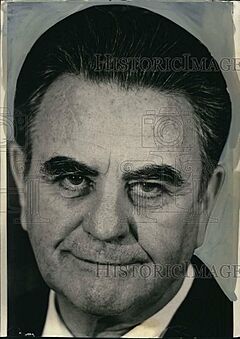John Sirica facts for kids
Quick facts for kids
John Sirica
|
|
|---|---|

Sirica in 1974
|
|
| Senior Judge of the United States District Court for the District of Columbia | |
| In office October 31, 1977 – August 14, 1992 |
|
| Chief Judge of the United States District Court for the District of Columbia | |
| In office 1971–1974 |
|
| Preceded by | Edward Matthew Curran |
| Succeeded by | George Luzerne Hart Jr. |
| Judge of the United States District Court for the District of Columbia | |
| In office March 28, 1957 – October 31, 1977 |
|
| Appointed by | Dwight D. Eisenhower |
| Preceded by | Henry Albert Schweinhaut |
| Succeeded by | Harold H. Greene |
| Personal details | |
| Born |
John Joseph Sirica
March 19, 1904 Waterbury, Connecticut, U.S. |
| Died | August 14, 1992 (aged 88) Washington, D.C., U.S. |
| Resting place | Gate of Heaven Cemetery Silver Spring, Maryland |
| Political party | Republican |
| Education | Georgetown University (LLB) |
John Joseph Sirica (born March 19, 1904 – died August 14, 1992) was a U.S. federal judge. He served on the United States District Court for the District of Columbia. Judge Sirica became very well-known for his important role in the trials related to the Watergate scandal.
Contents
Early Life and School Days
John Sirica was born in Waterbury, Connecticut. His parents, Ferdinando and Rose Sirica, were immigrants from Italy. John's family moved around a lot between 1910 and 1918. His father worked as a barber and tried to start small businesses.
In 1918, the Sirica family moved to Washington, D.C.. John went to Emerson Preparatory School and then Columbia Preparatory School. After high school, John went straight to law school. This was allowed in Washington, D.C., at that time. He studied at Georgetown Law and earned his law degree in 1926.
A Young Boxer and Lawyer
Before becoming a judge, John Sirica was a boxer. He fought in Washington and Miami during the 1920s and 1930s. He was good friends with the famous boxing champion Jack Dempsey.
Even though he loved boxing, Sirica chose a career in law. He worked as a private lawyer in Washington, D.C., from 1926 to 1930. Then, he became an Assistant United States Attorney for the District of Columbia. He held this job from 1930 to 1934. After that, he returned to private law practice until 1957.
Becoming a Federal Judge
On February 25, 1957, President Dwight D. Eisenhower chose John Sirica to be a federal judge. He was approved by the United States Senate on March 26, 1957. He officially became a judge for the United States District Court for the District of Columbia on March 28, 1957.
Judge Sirica served as the Chief Judge of the court from 1971 to 1974. He continued to serve as a judge until his death on August 14, 1992. One notable decision he made was ruling that a law stopping Navy women from serving on ships was against the Constitution.
His Role in the Watergate Scandal
Judge Sirica became famous across the country because of the Watergate scandal. He ordered President Richard Nixon to hand over secret recordings of his White House talks to federal investigators.
Sirica's involvement started when he was the judge for the trial of the people who broke into the Watergate building. He didn't believe they acted alone. He used a special method called "provisional sentencing." This meant he would give defendants a temporary sentence. This encouraged them to share more information about anyone else involved.
One of the defendants, James W. McCord Jr., wrote a letter. This letter revealed that more people from the Nixon administration were involved. This was a big step in uncovering the truth about Watergate.
"Maximum John" and His Style
Judge Sirica was known for being very serious and strict in court. He was an experienced trial lawyer himself. Some people called him "Maximum John." This nickname came from his tendency to give defendants the longest sentences allowed by law.
His critics sometimes said he was too harsh. However, many saw him as a hero for his strong actions during the Watergate trials. He pushed for the truth to come out, no matter how difficult.
Writing a Book
In 1979, Judge Sirica wrote a book with John Stacks. It was called To Set the Record Straight. The book shared his experiences and thoughts about the Watergate cases.
Later, a writer named Renata Adler reviewed his book. She questioned some parts of his past. She mentioned his connections to bootlegging (illegal alcohol sales) and illegal boxing.
Awards and Honors
For his important role in revealing the truth about Watergate, Judge Sirica received a major honor. In January 1974, Time magazine named him their Man of the Year.
In 1977, he also received the Golden Plate Award. This award was given by the American Academy of Achievement.
Later Life and Passing
Judge Sirica had a severe heart attack in 1976. In his later years, he faced several health problems. He got pneumonia in the weeks before he died. He also fell and broke his collarbone.
John Sirica passed away from cardiac arrest on August 14, 1992, at a hospital in Washington, D.C. He was buried at Gate of Heaven Cemetery in Silver Spring, Maryland. He was survived by his wife, Lucile, and his three children.

